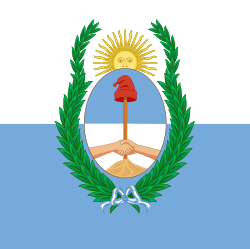Mendoza Province facts for kids

Mendoza is a large and important Province in Argentina. It is located in a region called Cuyo, in the western part of the country. Mendoza shares its borders with San Juan to the north, San Luis and La Pampa to the east. To the south, it borders Neuquén, and to the west, it touches Chile.
Mendoza is famous for being the biggest wine producer in Argentina. Many other crops also grow well here. The province is home to the highest mountain in the country, Aconcagua, which is part of the amazing Andes mountain range.
In 2001, Mendoza had a population of 1,579,651 people. While Spanish is the main language spoken, many people also speak English, Italian, and Portuguese.
| Provinces of Argentina | |
|---|---|
| Buenos Aires | Buenos Aires Province | Catamarca | Chaco | Chubut | Córdoba | Corrientes | Entre Ríos | Formosa | Jujuy | La Pampa | La Rioja | Mendoza | Misiones | Neuquen | Río Negro | Salta | San Juan | San Luis | Santa Cruz | Santa Fe | Santiago del Estero | Tierra del Fuego, Antarctica, and South Atlantic Islands | Tucumán | |
Contents
Geography and Nature
Mendoza Province has a very interesting landscape. It goes from high mountains to dry plains. The mighty Andes mountains form its western border. This is where you find Aconcagua, the tallest peak in the Americas.
Climate in Mendoza
The climate in Mendoza is mostly dry. It gets a lot of sunshine, which is great for growing grapes. Even though it's dry, the snowmelt from the Andes provides water. This water is used for farming through special irrigation systems.
Rivers and Water
Several rivers flow through Mendoza. The most important ones are the Mendoza River and the Diamante River. These rivers are fed by the melting snow from the mountains. They are vital for providing water to the cities and farms.
Economy and Wine Production
Mendoza's economy is strongly linked to its land. Farming is a very important activity here. The province is known worldwide for its delicious wines.
The Wine Capital
Mendoza is often called the "Wine Capital of Argentina." It has thousands of vineyards where grapes are grown. These grapes are then turned into many different types of wine. The dry climate and mountain water create perfect conditions for winemaking.
Other Crops
Besides grapes, farmers in Mendoza also grow other fruits and vegetables. These include olives, peaches, and apples. The province also produces olive oil, which is another important product.
Culture and History
Mendoza has a rich history and a vibrant culture. The province has been shaped by its original inhabitants and later by European settlers.
A Brief History
The area where Mendoza is located has been inhabited for thousands of years. Indigenous groups lived here long before Europeans arrived. The city of Mendoza was founded by the Spanish in 1561. Over time, it grew into an important center for trade and agriculture.
Festivals and Traditions
One of the most famous events in Mendoza is the National Grape Harvest Festival (Fiesta Nacional de la Vendimia). This festival celebrates the end of the grape harvest. It includes parades, music, and a beauty pageant. It's a big party that shows off the province's winemaking tradition.
Images for kids
-
View (looking West) from the Cabildo in the city of Mendoza, prior to the great quake of 1861.
-
The snowy Andes viewed from the National Route 7.
See also
 In Spanish: Provincia de Mendoza para niños
In Spanish: Provincia de Mendoza para niños








